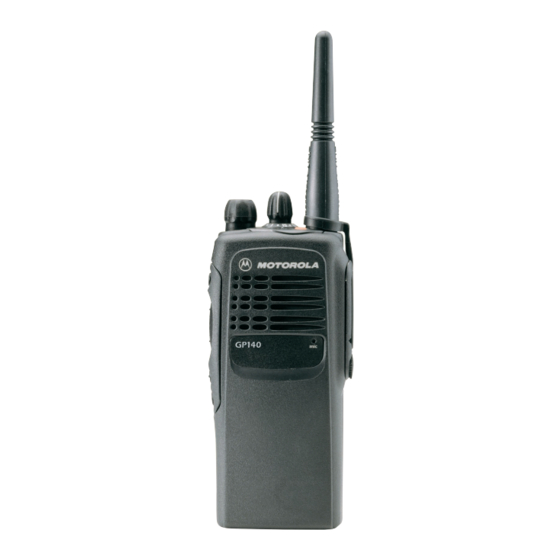Motorola GP1280 Series Basic Service Manual - Page 3
Browse online or download pdf Basic Service Manual for Portable Radio Motorola GP1280 Series. Motorola GP1280 Series 46 pages. Professional radio, power distribution and controller
Also for Motorola GP1280 Series: Service Information (32 pages), Service Information (30 pages), Service Information (30 pages)

SAFETY INFORMATION
Read this information before using your radio.
SAFE AND EFFICIENT OPERATION OF MOTOROLA TWO-WAY RADIOS
This document provides information and instructions for the safe and efficient operation of Motorola Portable and
Mobile Two-Way Radios. The information provided in this document supersedes the general safety information
contained in user guides published prior to 1 January 1998.
For information regarding radio use in hazardous areas, please refer to the Factory Mutual (FM) approval manual
supplement.
EXPOSURE TO RADIO FREQUENCY ENERGY
Your Motorola Two-Way Radio, which generates and radiates radio frequency (RF) electromagnetic energy
(EME), is designed to comply with the following National and International Standards and Guidelines regarding
exposure of human beings to radio frequency electromagnetic energy:
Federal Communications Commission Report and Order No. FCC 96-326 (August 1996)
American National Standards Institute (C95.1 - 1992)
National Council on Radiation Protection and Measurements (NCRP-1986)
International Commission on Non-Ionizing Radiation Protection (ICNRP- 1986)
European Committee for Electrotechnical Standardization (CENELEC):
- ENV 50166-1 1995 E
- ENV 50166-2 1995 E
- Proceedings of SC211/B 1996
To assure optimal radio performance and to ensure that your exposure to radio frequency electromagnetic
energy is within the guidelines in the above standards, always adhere to the following procedures:
PORTABLE RADIO OPERATION AND EME EXPOSURE
When transmitting with a portable radio, hold radio in a vertical position with the
microphone 2.5 to 5.0 centimeters (one to two inches) away from the mouth. Keep
antenna at least 2.5 centimeters (one inch) from your head or body when transmit-
ting.
If you wear a portable two-way radio on your body, ensure that the antenna is at
least 2.5 centimeters (one inch) from the body when transmitting.
ELECTROMAGNETIC INTERFERENCE/COMPATIBILITY
NOTE
Nearly every electronic device is susceptible to electromagnetic interference (EMI) if
inadequately shielded, designed, or alternately configured for electromagnetic compatibility.
To avoid electromagnetic interference and/or compatibility conflicts, turn off your radio in any facility where
posted notices instruct you to do so. Hospital or health facilities may be using equipment that is sensitive to
external RF energy.
When instructed to do so, turn off your radio when on board an aircraft. Any use of a radio must be in accor-
dance with airline regulations or crew instructions.
Human exposure to electromagnetic fields Low
frequency (0 Hz to 10 kHz)
Human exposure to electromagnetic fields High
frequency (10 kHz to 300 GHz)
"Safety Considerations for Human Exposure to EMFs from
Mobile Telecommunication Equipment (MTE) in the Fre-
quency Range 30MHz - 6 GHz." (EMF - Electro-Magnetic
Fields)
2.5 to 5.0 cm
(1 to 2 in.)
iii
